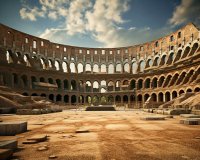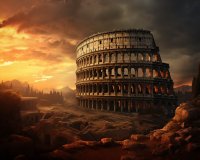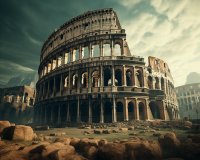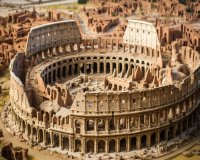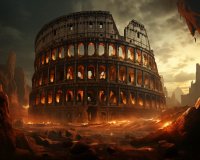A Day in Ancient Rome: Stories, Structures, and Spectacles
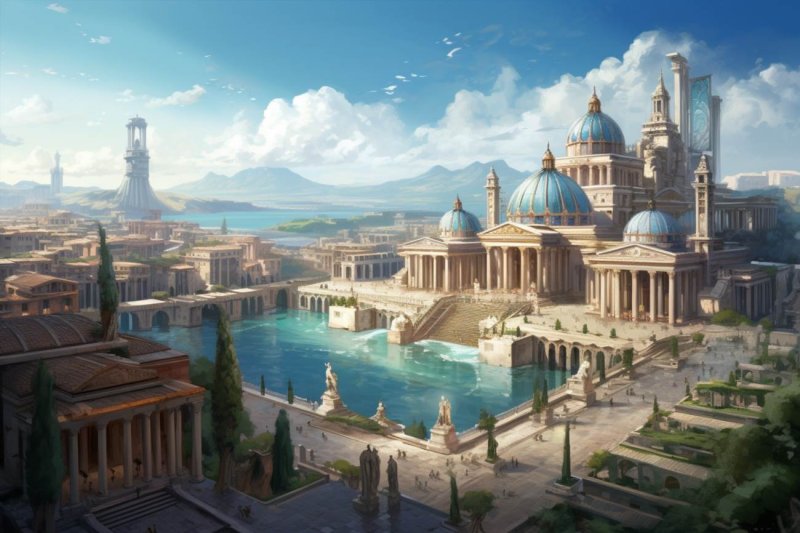
A Day in Ancient Rome: Stories, Structures, and Spectacles
Welcome to ancient Rome, a bustling metropolis of the past that laid the foundation for many aspects of modern society. In this article, we will take a journey back in time to explore a typical day in ancient Rome, delving into the stories, structures, and spectacular events that defined this remarkable civilization.
Morning in the Eternal City
The day in ancient Rome typically began at sunrise, as the city came to life with the sounds of traders, street vendors, and people heading to the bustling markets. One of the most iconic structures of Rome was the Roman Forum, a central hub for political, social, and commercial activities.
As the sun's rays illuminated the Forum's grand architecture, it became a stage for political debates, legal proceedings, and religious ceremonies. Senators, dressed in their distinctive togas, would gather here to discuss matters of state and governance.
Exploring Ancient Roman Architecture
Rome is renowned for its architectural marvels, and a key structure that defined the city was the Colosseum. This massive amphitheater, with a seating capacity of over 50,000, was where the Romans came to witness gladiatorial combat, chariot races, and other spectacles.
Just a short walk from the Colosseum, you would find the Roman Pantheon, a stunning temple dedicated to the gods. Its unique dome, with an oculus at its center, showcased the Romans' advanced architectural prowess. The Pantheon's construction remains an engineering marvel to this day.
For an example of everyday Roman life, we must not overlook the insulae, ancient Roman apartment buildings. These multi-story structures housed a significant portion of the city's population, with people from various social classes living in close quarters.
Afternoon in the City
As the day progressed, Romans enjoyed leisurely lunches, often including a variety of foods like bread, olive oil, wine, and fruits. One cannot forget the Roman bathhouses, such as the Baths of Caracalla, where citizens could relax, socialize, and cleanse themselves in grand, sprawling complexes.
Another remarkable structure was the Circus Maximus, an enormous arena used for chariot racing. This sporting event was immensely popular, drawing thousands of enthusiastic spectators. The excitement and rivalry that filled the air during chariot races are reminiscent of today's sports events.
Evening Entertainments
As the sun began to set, Romans would head to the Theatre of Marcellus to enjoy theatrical performances. These shows included comedies, tragedies, and even mime acts, providing entertainment for all social classes.
One of the most iconic structures, the Roman Aqueducts, played a vital role in supplying the city with clean water. The intricate network of aqueducts, such as the Aqua Claudia, transported water from distant sources into the heart of Rome, ensuring a steady supply for the citizens.
Conclusion: A Glimpse into Ancient Rome
A day in ancient Rome was filled with stories of political intrigue, the grandeur of architectural marvels, and the thrill of public spectacles. The structures and events of this remarkable civilization have left an indelible mark on our understanding of history and continue to captivate the world. As we reflect on A Day in Ancient Rome, we can't help but marvel at the enduring legacy of a society that shaped the course of history.
Rome: Palatine Hill & Roman Forum Ticket with Multimedia Experience
Dive into Rome's rich history by exploring the iconic sites of Palatine Hill and the Roman Forum. With these pre-booked tickets, you get the opportunity to traverse the ancient grounds where emperors, kings, and everyday citizens once tread.
Discover Rome's Ancient Heart
The Roman Forum is not just any ancient site. It was the heart of Roman political, social, and religious life. Here, you can trace the steps of legendary figures and find the tomb of the revered emperor Julius Caesar. The forum offers a window into the daily lives of Roman citizens and the pivotal events that shaped history.
The Birthplace of Rome: Palatine Hill
Just a short walk from the Roman Forum is the Palatine Hill. Considered the site where Rome was founded, it housed the most significant residences of emperors and royalty. As you stand atop this hill, you are standing at the center of the seven hills of Rome. Don't miss the panoramic views of the Eternal City, including a stunning vantage point to behold the majestic Colosseum.
Multimedia Insight into Ancient Rome
Enhance your journey into the past with a 25-minute multimedia video. This immersive experience provides deeper insights into the vibrant life and significant events of ancient Rome. Begin your exploration at the local partner's office, where this enlightening video awaits before you step into the historical sites.
Additional Information
For a smooth experience, ensure you exchange your voucher for your entry ticket at the designated Touristation office located at Piazza d'Aracoeli, 16. Notably, for the safety and security of all visitors, screenings will be conducted at the entrance.
Rome and Its Majestic Edifices
Rome, the eternal city, is a place steeped in history, culture, and architectural marvels. It's a city that has witnessed the rise and fall of empires and has left a profound mark on the world. One of the most captivating aspects of Rome is its majestic edifices that stand as a testament to its glorious past. In this article, we will explore some of the most iconic structures that adorn the cityscape of Rome.
The Colosseum
One cannot discuss Rome's majestic edifices without mentioning the Colosseum. This ancient amphitheater, also known as the Flavian Amphitheatre, is a marvel of Roman engineering and architecture. Built in 70-80 AD, it could hold an estimated 50,000 to 80,000 spectators and was the site of gladiatorial contests, animal hunts, and other public spectacles. The Colosseum's grandeur is still awe-inspiring, and it stands as a symbol of Rome's imperial power and architectural prowess.
The Pantheon
The Pantheon is another architectural gem in Rome. This temple, built around 125 AD, is a remarkable example of Roman concrete construction. It boasts the world's largest unreinforced concrete dome, which is a true marvel of engineering. The Pantheon was originally a temple dedicated to all the gods of ancient Rome and is now a church. Its oculus, a circular opening at the top of the dome, allows sunlight to filter into the interior, creating a mystical atmosphere.
The Roman Forum
The Roman Forum, often referred to as the heart of ancient Rome, is a sprawling archaeological site filled with the ruins of temples, basilicas, and government buildings. It was the center of Roman public life for centuries. Walking through the Forum, one can imagine the hustle and bustle of ancient Roman citizens engaged in political, social, and commercial activities. The Forum offers a glimpse into the city's rich history and its architectural evolution over the centuries.
The Vatican City
Within the boundaries of Rome lies the world's smallest independent state, the Vatican City. This sovereign city-state is the spiritual and administrative center of the Roman Catholic Church and is home to some of the most impressive religious edifices in the world. St. Peter's Basilica, with its iconic dome designed by Michelangelo, and the Sistine Chapel, adorned with Michelangelo's frescoes, are just a couple of the extraordinary structures within the Vatican. These sites are not only significant for their religious importance but also for their architectural beauty.
The Trevi Fountain
Rome is not just about ancient ruins and religious sites; it also boasts enchanting Baroque architecture. The Trevi Fountain is a prime example. Built in the 18th century, this grand fountain is a masterpiece of Baroque art and design. Visitors from all over the world come to toss a coin into the fountain, a tradition believed to ensure a return to Rome. The fountain's intricate sculptures and the play of light on the water make it a breathtaking sight, especially at night.
The Spanish Steps
The Spanish Steps, known as the "Scalinata di Trinità dei Monti" in Italian, are a set of 135 steps located in the Piazza di Spagna. This monumental stairway of irregular butterfly design is one of the most famous tourist attractions in Rome. It is adorned with numerous azaleas in the spring, creating a beautiful, colorful spectacle. The steps lead to the Trinità dei Monti church at the top, offering panoramic views of the city.
Conclusion
Rome's majestic edifices, spanning from ancient Roman amphitheaters to Baroque fountains and churches, are a testament to the city's rich history and its enduring influence on architecture and culture. These remarkable structures continue to draw visitors from all over the world, offering a glimpse into the grandeur of Rome's past and its enduring beauty.
Rome: Colosseum Arena, Roman Forum, and Palatine Hill Tour
Discover the history and grandeur of ancient Rome on a guided tour that takes you through the Colosseum's arena floor, the Roman Forum, and the Palatine Hill. Follow your expert guide as they lead you on a captivating journey into the world of gladiators and Roman emperors.
Highlights
Experience the following highlights on this tour:
- Gladiator Insights: Immerse yourself in the world of gladiators as you step through the Gladiators' Gate at the Colosseum. Learn about their lives, training, and the brutal games that unfolded within this iconic arena.
- Engineering Marvels: Gain a deeper understanding of the complex engineering systems beneath the Colosseum's arena floor that made seemingly magical appearances of animals and provided the backdrop for life-or-death battles.
- Emperor's Triumphs: Visit the triumphal arches of two legendary emperors, Titus and Constantine, and witness the tangible remnants of a mighty empire's rise to power.
- Panoramic Views: Climb the historic Palatine Hill to enjoy breathtaking views of the sprawling city below.
Choose between a private or group tour to explore the Colosseum, Roman Forum, and Palatine Hill according to your preferences.
Full Description
Step into history with a guided walking tour that explores the Colosseum, the Roman Forum, and Palatine Hill. As you walk through the Colosseum's arena floor, you can almost hear the roaring crowds and feel the intensity of the gladiator games. Your guide will regale you with stories of these ancient sportsmen.
Discover the incredible engineering feats accomplished by the Romans, allowing for dramatic entrances of animals and the grim conditions faced by gladiators before their fateful battles. With exclusive access to the arena floor, you'll witness firsthand the complexity of the Colosseum's operations.
Continue your journey by visiting the nearby triumphal arches of Emperors Titus and Constantine, rare remnants of Rome's powerful past. These arches serve as a testament to the might and influence of one of history's greatest empires.
Make the most of your visit by selecting a private or group tour, ensuring your experience of the Colosseum, Roman Forum, and Palatine Hill aligns with your preferences.
Includes
This tour includes:
- Knowledgeable Guide
- Engaging Walking Tour
- Access to the Colosseum's Arena Floor
- Entry to Palatine Hill
- Entry to the Roman Forum
- Headset for Enhanced Experience
Meeting Point
Meet your guide at the Arch of Constantine, conveniently located near the Piazza del Arco di Costantino.
Important Information:
Before embarking on this tour, remember to bring your passport or ID card and wear comfortable shoes. If you're traveling with children, ensure they have their passports or ID cards as well. Please be aware that pets, weapons, large bags, drones, selfie sticks, and umbrellas are not allowed on the premises.
For all visitors' safety, security measures similar to those at the airport are in place. Additionally, in the event of insufficient participants, there may be changes to the tour itinerary.
Tales from the Heart of the Eternal City: Rome
Rome, the Eternal City, is a place steeped in history and legend. Its ancient streets echo with the footsteps of emperors, poets, and saints. From the grandeur of the Colosseum to the serenity of the Vatican, every corner of this city tells a story.
Historical Marvels
At the heart of Rome lies the Colosseum, an architectural marvel that once hosted gladiatorial contests and grand spectacles. Its towering arches and weathered stone bear witness to centuries of human endeavor. As you stand within its walls, you can almost hear the cheers of the ancient Romans.
Adjacent to the Colosseum stands the Roman Forum, a sprawling complex of ruins that was once the political, religious, and commercial center of the city. Here, among the fallen columns and shattered statues, you can glimpse the grandeur of ancient Rome.
Spiritual Center
The Vatican City, an independent city-state within Rome, is the spiritual heart of the Catholic world. St. Peter's Basilica, with its magnificent dome and awe-inspiring architecture, is a testament to human devotion. Inside, Michelangelo's Pieta and the intricacies of Bernini's baldachin leave visitors in silent contemplation.
Beneath the basilica lies the Vatican Necropolis, where the tomb of St. Peter is said to be located. This sacred site draws pilgrims from around the globe, seeking a connection to the roots of their faith.
Renaissance Splendor
The art and architecture of Rome are not confined to antiquity. The city served as the cradle of the Renaissance, nurturing talents like Leonardo da Vinci, Raphael, and Caravaggio. The Vatican Museums house an unparalleled collection of artistic treasures, including the sublime frescoes of the Sistine Chapel.
The Trevi Fountain, a baroque masterpiece, invites visitors to make a wish and toss a coin into its turquoise waters. This tradition ensures that Rome's fountains are not only marvels of engineering but also vessels of hope and dreams.
Hidden Gems
Amidst the grandeur of Rome, there are hidden treasures waiting to be discovered. The Capuchin Crypt, adorned with the bones of over 4,000 monks, is a somber reminder of the impermanence of life. The Aventine Keyhole offers a unique perspective of the city, framing St. Peter's Basilica perfectly.
Culinary Delights
Roman cuisine is a feast for the senses. From the crispy, thin-crust pizza bianca to the creamy carbonara, every dish reflects the simplicity and richness of Italian gastronomy. Trastevere, with its cobbled streets and charming trattorias, is a culinary haven where you can savor the authentic flavors of Rome.
Conclusion
Rome is not merely a city; it is a living testament to the resilience of human civilization. Its streets are woven with tales of triumph and tragedy, of artistry and devotion. To walk through Rome is to walk through history itself, a journey through the heart of the Eternal City.


